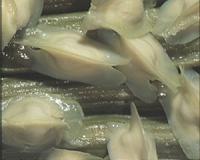| . |  |
. |
New Delhi (AFP) March 8, 2010 India faces a water crisis with availability in decline and demand rocketing, and the profligate agricultural sector is in the firing line. Farmers' wasteful use of water is unsustainable in a country with a fast-growing population and rapidly industrialising economy, says Water Resources Minister Pawan Kumar Bansal. Agriculture "is going to face tough competitive demands from other sectors", Bansal told a water management conference in New Delhi recently. "To feed 17 percent of the world's population we have only four percent of the world's water resources," he warned. India's overall annual water consumption is expected to almost double from 634 billion cubic metres (BCM) to 1,180 BCM by 2050, according to the Central Water Commission. The ministry of water resources predicts per capita water availability by 2050 to be less than half 2001 levels. The concerns coincide with new worries about India's ability to feed itself as another failed monsoon hits crop yields. Food prices are up about 18 percent over 12 months and swathes of parched earth in the countryside serve as a stark reminder of how water is inextricably linked to Indian poverty. Last year's monsoon was the weakest since 1972, which meant the more than 100 million Indian farmers who rely solely on the rains to water their fields were left high and dry. "What we should do, given the water requirements and demand and supply imbalance, is promote water-saving technologies like sprinklers," said Usha Tuteja, of the Agricultural Economics Research Centre at Delhi University. Experts say free water supplies for those farmers lucky enough to live near government irrigation canals and rivers encourages waste and inefficiency. Many farmers flood their crops, using more water than they need to, and often choose water-intensive crops in areas with low rainfall. Bansal believes pricing water to reflect its scarcity would deter waste and force farmers to take "the last drop to the last mile." But most farmers are reluctant to pay for something they take for granted now, and most Indian farmers are small-scale operators who would be unable to shoulder the cost. "The policy needs rethinking. Only small and marginal farmers who are below the poverty line should get these inputs for free," Tuteja said. Anil Jain, managing director of Jain Irrigation Systems, which sells micro-irrigation systems that use less water, believes his company is part of the solution. The company sells products that feed water to the roots of crops or the soil directly through small devices such as pipes and valves. "What farmers are doing today is flooding the entire land," Jain said. "Our concept is you need not irrigate the land, you need to irrigate the crop and provide water to the root." Sprinklers and micro-irrigation techniques such as drip irrigation consume only half of what a farmer would normally spray on crops, and less water means less energy required to pump it out. Micro-irrigation also reduces the amount of fertilisers and pesticides which contaminate declining groundwater supply through runoff from excessive watering of fields. It can even increase crop output by 40 percent, said Jain. But many farmers are put off by the investment required in drip irrigation technology -- around 1,000 US dollars per hectare -- though there are government incentives which reimburse half the cost. Jain believes such technologies will spread slowly across India as water becomes a major national development issue. But "it is going to take decades of work", he admitted.
Share This Article With Planet Earth
Related Links Water News - Science, Technology and Politics
 Worlds Most Usefull Tree Provides Low-Cost Water Purification
Worlds Most Usefull Tree Provides Low-Cost Water PurificationWashington DC (SPX) Mar 08, 2010 A low-cost water purification technique published in Current Protocols in Microbiology could help drastically reduce the incidence of waterborne disease in the developing world. The procedure, which uses seeds from the Moringa oleifera tree, can produce a 90.00% to 99.99% bacterial reduction in previously untreated water, and has been made free to download as part of access programs under ... read more |
|
| The content herein, unless otherwise known to be public domain, are Copyright 1995-2010 - SpaceDaily. AFP and UPI Wire Stories are copyright Agence France-Presse and United Press International. ESA Portal Reports are copyright European Space Agency. All NASA sourced material is public domain. Additional copyrights may apply in whole or part to other bona fide parties. Advertising does not imply endorsement,agreement or approval of any opinions, statements or information provided by SpaceDaily on any Web page published or hosted by SpaceDaily. Privacy Statement |